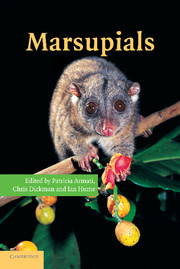Book contents
- Frontmatter
- Contents
- List of Contributors
- Preface
- 1 The evolution and classification of marsupials
- 2 What marsupials can do for genetics and what genetics can do for marsupials
- 3 Reproduction
- 4 Lactation
- 5 Nutrition and digestion
- 6 The nervous system
- 7 The immunolymphatic system
- 8 Ecology and life histories
- 9 Behaviour
- 10 Conservation and management
- References
- Index
- Plate Section
1 - The evolution and classification of marsupials
Published online by Cambridge University Press: 07 August 2009
- Frontmatter
- Contents
- List of Contributors
- Preface
- 1 The evolution and classification of marsupials
- 2 What marsupials can do for genetics and what genetics can do for marsupials
- 3 Reproduction
- 4 Lactation
- 5 Nutrition and digestion
- 6 The nervous system
- 7 The immunolymphatic system
- 8 Ecology and life histories
- 9 Behaviour
- 10 Conservation and management
- References
- Index
- Plate Section
Summary
A bit of history
Marsupials have been known to European biologists almost since the discovery of the Americas at the end of the fifteenth century; properly classifying them took some time. While the novelty of the opossum's pouch was instantly appreciated, no special position outside the then-usual classification of mammals seemed needed. Nor could this easily have been done: most arrangements of the time were relatively simple in structure and oriented toward European animals, and these limitations persisted into the eighteenth century. Regardless of his greed for new and exotic specimens, Linnaeus's classifications remained ‘folk-like’ in this sense; and he named and placed Didelphis in a group along with insectivores, armadillos and the pig in his 1758 edition of the Systema naturae, the conventional starting-point for modern animal taxonomy. By that year naturalists were aware of several species of opossums – which seemed pretty much to be minor variations on the same theme – but the earliest, seventeenth-century, descriptions of the more distinctive Australasian marsupials (e.g. cuscuses Phalanger spp. and tammar wallaby Macropus eugenii) did not immediately come to scientific attention. The diversity and range of adaptive differences amongst antipodean marsupials really became obvious only with Captain Cook's voyages, beginning in 1768, and the settlement of New South Wales.
The eastern grey kangaroo Macropus giganteus was among the first discovered, and it obviously was not an opossum.
Information
- Type
- Chapter
- Information
- Marsupials , pp. 1 - 21Publisher: Cambridge University PressPrint publication year: 2006
Accessibility standard: Unknown
Why this information is here
This section outlines the accessibility features of this content - including support for screen readers, full keyboard navigation and high-contrast display options. This may not be relevant for you.Accessibility Information
- 9
- Cited by
